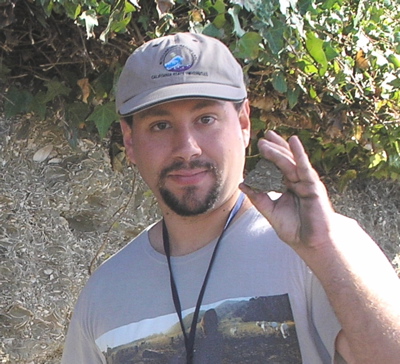
by Jeremiah Brower, Geological Oceanography Lab
Over the last couple of years I’ve learned that certain grants have been difficult to get because some people don’t consider Marine Geologists (or Geologic Oceanographers…the terms are interchangeable, one just seems to roll off the tongue better) as “actual” geologists because they don’t consider us to be “field scientists.” While there is a certain amount of truth in that, due to advances in software technology (much of our work involves computers and mapping programs), we still need to go outside to collect the data in the first place! Even the oceanographers who focus on the creation of habitat maps need to spend years surveying in the field before they can sit down in front of a computer and decide how best to play with the numbers.

Case in point – early one Saturday I was out on the beach, hunting not for shells like so many tourists, but little green rocks. Another student from Moss Landing needed to find iron-rich rocks to see how iron affects the growth rates of various species of kelp. I offered to help him out and so I grabbed my rock hammer, hand lense, field notebook and we meet up at a beach just south of Santa Cruz. It was early in the day but we still needed to weave our way through a plethora of tourists to find a good exposed cliff-face. We were on a hunt for Glauchonite, a green, rounded rock that is formed in shallow marine sediments by the compaction of iron ore and…..well…….fish poop! (Or ‘fecal pellets’ as they are very scientifically called.) Small samples of Glauchonite can be found all over the Purisima formation I wrote about earlier, and they are rich in iron, so would provide a good test for the kelp experiment.
Traveling down the beach and climbing up cliffs, I guided my kelp-loving friend through thousands of years of history until we found a promising exposure of rock. Hacking away at it may have drawn some questionable looks from the beach-patrol, but humans are agents of erosion anyway, so we were just doing our part! We found some good samples of the green rock and took a moment to enjoy the day before heading out. I think it was a smart move to pick a profession that would let me spend most of my life on a beach, and Saturday’s “rock hunt” was a perfect example of why I love the science. Marine Geology IS Geology……now if we could just get that grant we could buy a new cappuccino machine!
Sand man signing out.

